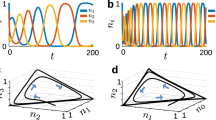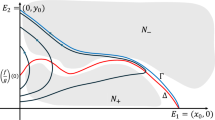Abstract
A species is semelparous if every individual reproduces only once in its life and dies immediately after the reproduction. While the reproduction opportunity is unique per year and the individual’s period from birth to reproduction is just n years, the individuals that reproduce in the ith year (modulo n) are called the ith year class, i = 1, 2, . . . , n. The dynamics of the n year-class system can be described by a differential equation system of Lotka–Volterra type. For the case n = 4, there is a heteroclinic cycle on the boundary as shown in previous works. In this paper, we focus on the case n = 4 and show the existence, growth and disappearance of periodic orbits near the heteroclinic cycle, which is a part of the conjecture by Diekmann and van Gils (SIAM J Appl Dyn Syst 8:1160–1189, 2009). By analyzing the Poincaré map near the heteroclinic cycle and introducing a metric to measure the size of the periodic orbit, we show that (i) when the average competitive degree among subpopulations (year classes) in the system is weak, there exists an asymptotically stable periodic orbit near the heteroclinic cycle which is repelling; (ii) the periodic orbit grows in size when some competitive degree increases, and converges to the heteroclinic cycle when the average competitive degree tends to be strong; (iii) when the average competitive degree is strong, there is no periodic orbit near the heteroclinic cycle which becomes asymptotically stable. Our results provide explanations why periodic solutions expand and disappear and why all but one subpopulation go extinct.
Similar content being viewed by others
References
Adamic LA, Huberman BA (2000) Powerlaw distribution of the world wide web. Science 287: 2115
Behncke H (2000) Periodical cicadas. J Math Biol 40: 413–431
Bulmer MG (1977) Periodic insects. Am Nat 111: 1099–1117
Cushing JM (2006) Nonlinear semelparous Leslie models. Math Biosci Eng 3: 17–36
Cushing JM (2009) Three stage semelparous Leslie models. J Math Biol 59: 75–104
Davydova NV (2004) Old and young. Can they coexist? thesis, University of Utrecht. http://igitur-archive.library.uu.nl/dissertations/2004-0115-092805/UUindex.html
Davydova NV, Diekmann O, van Gils SA (2003) Year class competition or competitive exclusion for strict biennials?. J Math Biol 46: 95–131
Davydova NV, Diekmann O, van Gils SA (2005) On circulant populations. I. The algebra of semelparity. Linear Algebra Appl 398: 185–243
Diekmann O, van Gils SA (2003) Invariance and symmetry in a year-class model, in bifurcations, symmetry and patterns (Porto, 2000). pp 141–150. Birkhäuser, Basel
Diekmann O, van Gils SA (2009) On the cyclic replicator equation and the dynamics of semelparous populations. SIAM J Appl Dyn Syst 8: 1160–1189
Edalat A, Zeeman EC (1992) The stable classes of the codimension-one bifurcations of the planar replicator system. Nonlinearity 5: 921–939
Hofbauer J (1987) Heteroclinic cycles on the simplex. Farkas M, Kertész V, Stépán G (eds) Proc Int Conf Nonlinear Oscillations. Janos Bolyai Mathematical Society, Budapest
Hofbauer J, Sigmund K (1988) The theory of evolution and dynamical system: mathematical aspects of selection. London Mathematical Society Student Texts, vol 7. Cambridge University Press, Cambridge
Hofbauer J, Sigmund K (1998) Evolutionary games and population dynamics. Cambridge University Press, Cambridge
Kon R (2005) Nonexistence of synchronous orbits and class coexistence in matrix population models. SIAM J Appl Math 66: 616–626
Kon R, Iwasa Y (2007) Single-class orbits in nonlinear Leslie matrix models for semelparous populations. J Math Biol 55: 781–802
Lopez L, Sanjuan MAF (2001) Defining strategies to win in the Internet market. Physica A 301: 512–534
Mjolhus E, Wikan A, Solberg T (2005) On synchronization in semelparous populations. J Math Biol 50: 1–21
Murry JD (1993) Mathematical biology. Springer, New York
van den Drissche P, Zeeman ML (1998) Three-dimensional competitive Lotka–Volterra systems with no periodic orbits. SIAM J Appl Math 58: 227–234
Wang Y (2003) Necessary and sufficient conditions for the existence of periodic orbits in a Lotka–Volterra system. J Math Anal Appl 284: 236–249
Wang Y, Wu H (2011) A mutualism-competition model characterizing competitors with mutualism at low density. Math Comput Model 53: 1654–1663
Xiao D, Li W (2000) Limit cycles for the competitive three dimensional Lotka–Volterra system. J Differ Equ 164: 1–15
Zeeman ML (1993) Hopf bifurcation in competitive three-dimensional Lotka–Volterra systems. Dyn Stab Syst 8: 189–217
Zeeman EC, Zeeman ML (2002) From local to global behavior in competitive Lotka–Volterra systems. Trans Am Math Soc 355: 713–734
Author information
Authors and Affiliations
Corresponding author
Additional information
Y. Wang acknowledges partial support from NSFC of People’s Republic of China (No. 10871214).
S. Ruan acknowledges partial support from NSF grant DMS-1022728.
Rights and permissions
About this article
Cite this article
Wang, Y., Wu, H. & Ruan, S. Periodic orbits near heteroclinic cycles in a cyclic replicator system. J. Math. Biol. 64, 855–872 (2012). https://doi.org/10.1007/s00285-011-0435-3
Received:
Revised:
Published:
Issue Date:
DOI: https://doi.org/10.1007/s00285-011-0435-3




